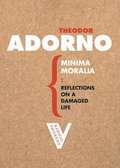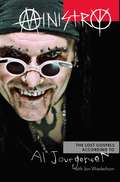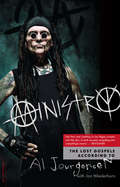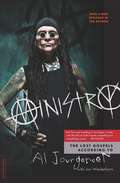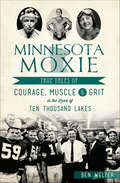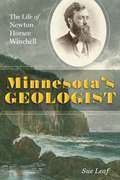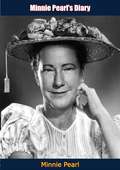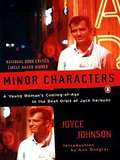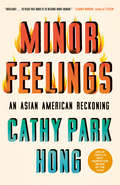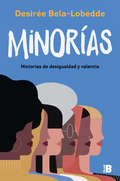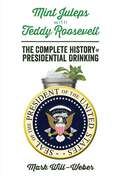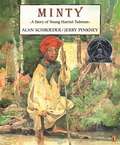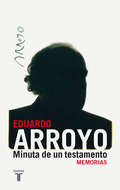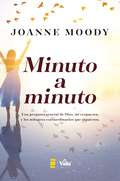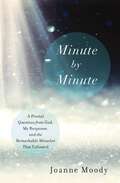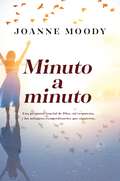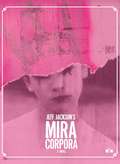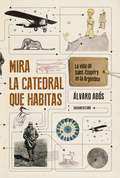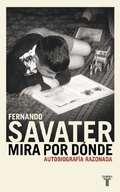- Table View
- List View
Minima Moralia: Reflections on a Damaged Life
by Theodor W. Adorno E. F. N. JephcottA reflection on everyday existence in the 'sphere of consumption of late Capitalism', this work is Adorno's literary and philosophical masterpiece.
Ministers at War: Winston Churchill and His War Cabinet
by Jonathan SchneerIn May 1940, with France on the verge of defeat, Britain alone stood in the path of the Nazi military juggernaut. Survival seemed to hinge on the leadership of Winston Churchill, whom the King reluctantly appointed Prime Minister as Germany invaded France. Churchill’s reputation as one of the great twentieth-century leaders would be forged during the coming months and years, as he worked tirelessly first to rally his country and then to defeat Hitler. But Churchill--regarded as the savior of his nation, and of the entire continent--could not have done it alone. As prize-winning historian Jonathan Schneer reveals inMinisters at War, Churchill depended on a team of powerful ministers to manage the war effort as he rallied a beleaguered nation. Selecting men from across the political spectrum--from fellow Conservative Anthony Eden to leader of the opposing socialist Labor Party Clement Attlee--Churchill assembled a War Cabinet that balanced competing interests and bolstered support for his national coalition government. The group possessed a potent blend of talent, ambition, and egotism. Led and encouraged by Churchill, the ministers largely set aside their differences, at least at first. As the war progressed, discord began to grow. It reached a peak in 1945: with victory seemingly assured, Churchill was forced by his Minsters at War to dissolve the Government and call a General Election, which, in a shocking upset, he lost to his rival Attlee. Authoritatively recasting our understanding of British high politics during World War II, Schneer shows that Churchill managed the war effort by managing his team of supremely able yet contentious cabinet members. The outcome of the war lay not only in Churchill’s individual brilliance but also in his skill as an executive, and in the collective ability of men who muted their personal interests to save the world from barbarism.
Ministry
by Al JourgensenMinistry is a memoir both ugly and captivating, revealing Al Jourgensen as a man who lived a hard life his own way without making compromises. He survived prolonged drug addiction--twenty-two years of chronic heroin, cocaine, and alcohol abuse, to be more precise--before cleaning up, straightening out, and finding new reasons to live.During his career, Jourgensen has engaged in all of the rock 'n' roll clichés regarding decadence and debauchery and invented new forms of previously unachieved nihilism. Despite this and his addictions, he created seven seminal albums, including the bonafide, hugely influential classic The Land of Rape and Honey, 1989's The Mind is a Terrible Thing to Taste, and 1992's blockbuster Psalm 69: The Way to Succeed.Ministry imparts the epic life of Al Jourgensen, a survivor who tempted fate, beat the odds, persevered, and put the pieces back together after unraveling completely.
Ministry
by Al JourgensenThe high-octane, no-holds-barred memoir by legendary godfather of industrial musicOCoAl Jourgensen, the founder of Ministry"
Ministry
by Al JourgensenThe high-octane, no-holds-barred memoir by legendary godfather of industrial musicOCoAl Jourgensen, the founder of Ministry"
Ministry: The Lost Gospels According to Al Jourgensen
by Al JourgensenMinistry: The Lost Gospels is both ugly and captivating, revealing a character who has lived a hard life his way, without compromise. Jourgensen, one of the most innovative and prolific artists ever to pick up a guitar, mandolin, harmonica, or banjo, wanted to be a musician, yet became a rock star. And fame and fortune almost killed him. An IV drug abuser from the age of fifteen, Jourgensen delved deeper into heroin, cocaine, methadone, and alcohol for twenty-two years before cleaning up, straightening out, and finding new reasons to live. Filled with humor, heart, decadence, and tragedy, Ministry depicts the epic life of a renegade iconoclast.
Minnesota Moxie: True Tales of Courage, Muscle & Grit in the Land of Ten Thousand Lakes
by Ben WelterMinnesotans are a tough lot, capable of pulling a house six miles by muscle alone or giving birth to a sixteen-pound boy. In 1921, young Phoebe Fairgrave set a parachute world record, stepping off the wing of a biplane 15,200 feet above the Twin Cities. In 1962, the last powerhouse Gophers football team brought home the Rose Bowl trophy. A year later, thirteen-year-old Jean Webb of Minneapolis risked arrest and refused to leave a segregated restaurant. In 1979, Gerry Spiess crossed the Atlantic alone in a 10-foot sailboat he built in his White Bear Lake garage. These inspiring stories and dozens more, culled from the Star Tribune newspaper archives, are presented in their original form by author Ben Welter, along with in-depth background, fresh interviews and more than seventy-five historic photos.
Minnesota's Geologist: The Life of Newton Horace Winchell
by Sue LeafWinner of the 2021 Minnesota Book Award for Minnesota Nonfiction The story of the scientist who first mapped Minnesota&’s geology, set against the backdrop of early scientific inquiry in the state At twenty, Newton Horace Winchell declared, &“I know nothing about rocks.&” At twenty-five, he decided to make them his life&’s work. As a young geologist tasked with heading the Minnesota Geological and Natural History Survey, Winchell (1839–1914) charted the prehistory of the region, its era of inland seas, its volcanic activity, and its several ice ages—laying the foundation for the monumental five-volume Geology of Minnesota. Tracing Winchell&’s remarkable path from impoverished fifteen-year-old schoolteacher to a leading light of an emerging scientific field, Minnesota&’s Geologist also recreates the heady early days of scientific inquiry in Minnesota, a time when one man&’s determination and passion for learning could unlock the secrets of the state&’s distant past and present landscape.Traveling by horse and cart, by sailboat and birchbark canoe, Winchell and his group surveyed rock outcrops, river valleys, basalt formations on Lake Superior, and the vast Red River Valley. He studied petrology at the Sorbonne in Paris, bringing cutting-edge knowledge to bear on the volcanic rocks of the Arrowhead region. As a founder of the American Geological Society and founding editor of American Geologist, the first journal for professional geologists, Winchell was the driving force behind scientific endeavor in early state history, serving as mentor to many young scientists and presiding over a household—the Winchell House, located on the University of Minnesota&’s present-day mall—that was a nexus of intellectual ferment. His life story, told here for the first time, draws an intimate picture of this influential scientist, set against a backdrop of Minnesota&’s geological complexity and splendor.
Minnesota's Notorious Nellie King: Wild Woman of the Closed Frontier (True Crime Ser.)
by Jerry KuntzThis true crime biography chronicles the misadventures of a lady outlaw who caused havoc across the late-19th century northern plains. The American historian Frederick Jackson Turner famously declared the 1890s to be the close of the American Frontier. But from 1887 to 1893, a young woman known as Nellie King was far from being tamed. King scandalized the residents of the Dakotas, Minnesota and northern Wisconsin with her fetching appearance, eccentric behavior, and criminal misdeeds. In Minnesota&’s Notorious Nellie King, biographer Jerry Kuntz pieces together King&’s legendary life—as well as the clues to her true identity. King employed more than a dozen aliases throughout her career as a fake detective, horse thief, laudanum fiend, and general disturber of the peace across the northern plains. She attracted sensational headlines, love-struck suitors, and stray revolver shots with equal abandon; her story&’s Dickensian cast of characters included a hapless counterfeiter, a dashing physician, a battle-hardened magician, and a determined mother.
Minnie Pearl’s Diary
by Minnie PearlSarah Ophelia Colley, takes on her well-known alter ego Minnie Pearl to write a quaint diary in her inimitable Southern Country style.“Dear Folks:Up to now, you’ve only heard what she could tell on the air. But at last she’s been persuaded to give us her secret diary—writ by hand.We asked her for some information “to put on the outside of the book” and this is what she sent us:BIRTHPLACE: Grinder’s Switch, 3 miles west of Centerville (not even a wagon greasin’). Population 300 folks; 350 dogs.DATE OF BIRTH: Age is a relative matter and that’s her trouble—too many relatives—she’s in her early fifties—young enough to wink at the fellers; too old to have them wink back.FAMILY: Minnie has a brother, a sister, Uncle Nabob, Aunt Ambrosy, Coz Elmer, etc., etc., etc.SCHOOLING: Minnie Pearl went all the way through Grinder’s Switch Elementary School—several times.CHILDHOOD ACTIVITIES: She enjoyed carefree life at Grinder’s Switch, early interest in fellers, kissing games, coon hunts, possum hunts, kissing games, swimming in Duck River, watching the train go through, kissing games.LATER ACTIVITIES: She participates—invited or not—in all activities at Grinder’s Switch with heavy emphasis on efforts to snare a husband. She is the social leader of Grinder’s Switch, showing keen interest in ice cream socials, church socials, and any other parties where they play games, especially kissing games. B(u )y now!”
Minor Characters
by Joyce JohnsonJack Kerouac. Allen Ginsberg. William S. Burroughs. LeRoi Jones. Theirs are the names primarily associated with the Beat Generation. But what about Joyce Johnson (nee Glassman), Edie Parker, Elise Cowen, Diane Di Prima, and dozens of others? These female friends and lovers of the famous iconoclasts are now beginning to be recognized for their own roles in forging the Beat movement and for their daring attempts to live as freely as did the men in their circle a decade before Women's Liberation. Twenty-one-year-old Joyce Johnson, an aspiring novelist and a secretary at a New York literary agency, fell in love with Jack Kerouac on a blind date arranged by Allen Ginsberg nine months before the publication of On the Road made Kerouac an instant celebrity. While Kerouac traveled to Tangiers, San Francisco, and Mexico City, Johnson roamed the streets of the East Village, where she found herself in the midst of the cultural revolution the Beats had created. Minor Characters portrays the turbulent years of her relationship with Kerouac with extraordinary wit and love and a cool, critical eye, introducing the reader to a lesser known but purely original American voice: her own. .
Minor Feelings: An Asian American Reckoning
by Cathy Park HongPoet and essayist Cathy Park Hong fearlessly and provocatively blends memoir, cultural criticism, and history to expose fresh truths about racialized consciousness in America. Part memoir and part cultural criticism, this collection is vulnerable, humorous, and provocative—and its relentless and riveting pursuit of vital questions around family and friendship, art and politics, identity and individuality, will change the way you think about our world. Binding these essays together is Hong’s theory of “minor feelings.” <P><P> As the daughter of Korean immigrants, Cathy Park Hong grew up steeped in shame, suspicion, and melancholy. She would later understand that these “minor feelings” occur when American optimism contradicts your own reality—when you believe the lies you’re told about your own racial identity. Minor feelings are not small, they’re dissonant—and in their tension Hong finds the key to the questions that haunt her. With sly humor and a poet’s searching mind, Hong uses her own story as a portal into a deeper examination of racial consciousness in America today. This intimate and devastating book traces her relationship to the English language, to shame and depression, to poetry and female friendship. A radically honest work of art, Minor Feelings forms a portrait of one Asian American psyche—and of a writer’s search to both uncover and speak the truth.
Minorías: Historias de desigualdad y valentía
by Desirée Bela-Lobedde«Qué pasa cuando, además de ser mujer, se es negra, migrante o asiática, se padece una enfermedad crónica o se vive en situación de discapacidad?» Minorías, de la activista Desirée Bela-Lobedde, es un ensayo imprescindible y lúcido en el que la autora conversa con mujeres que viven situaciones de discriminación o que pertenecen a una comunidad asociada a ciertos estereotipos y prejuicios y relegada a los márgenes. Así, conoceremos de primera mano sus honestos testimonios y aprenderemos de sus emocionantes pero también dolorosas historias, cuyo denominador común es una sociedad que muchas veces segrega y castiga la diferencia. «He escrito este libro con el propósito de explicar lo que hay detrás de las etiquetas que se imponen a las mujeres: mujer asiática, mujer gitana, mujer trabajadora sexual...»
Mint Juleps with Teddy Roosevelt: The Complete History of Presidential Drinking
by Mark Will-WeberIn the more than two-hundred-year history of the American presidency, there has been one element present in each and every administration: alcohol.In the beginning, there was George Washington, who sold whiskey distilled at Mount Vernon and preferred to quaff a well-crafted port. More than two hundred years later, Barack Obama beckoned some master brewers to advise his White House staff on how to make mouth-watering batches of White House Honey Ale with a key ingredient from Michelle Obama's beehives.And then there was the matter of the forty-two other gentlemen in between...Journalist Mark Will-Weber strolls through our country's memorable moments--from the Founding Fathers to the days of Prohibition, from impeachment hearings to diplomatic negotiations--and the role that a good stiff drink played in them in his new book, Mint Juleps with Teddy Roosevelt: The Complete History of Presidential Drinking.So grab a cocktail and turn the pages of Mint Juleps with Teddy Roosevelt for a unique and entertaining look into the liquor cabinets and the beer refrigerators of the White House. Cheers!
Minty: A Story of Young Harriet Tubman
by Jerry Pinkney Alan SchroederMany people know about Harriet Tubman's adult life--how she helped hundreds of slaves escape to freedom along the Underground Railroad. But how many know about Harriet Tubman's life as a child? This dramatic portrayal is illustrated in full color by four-time Caldecott Honor recipient Jerry Pinkney.
Minuta de un testamento: Memorias
by Eduardo ArroyoEl autorretrato de toda una generación de postguerra, exilio, lucha antifranquista, bohemia y, finalmente, libertad, éxito y glamour. Las memorias de Eduardo Arroyo, artista en sentido amplio e intelectual de primera línea, tienen la vocación de ser leídas como «una sarta de confidencias plagadas de historias» y de «dejarlo todo dicho, todo cosido, todo atado». Inspiradas en la Minuta de un testamento de Gumersindo de Azcárate, estas memorias tejidas de recuerdos, reflexiones, anécdotas, retratos y mucho humor, cubren en un desorden perfecto su adolescencia en el Madrid los años cincuenta, su exilio en París, donde su obra, marcada por cierta obsesión por la España franquista, fue muy bien recibida y valorada, su gusto por el Whisky J&B, las dificultades de la creación artística, sus viajes a Cuba o su amistad con Jorge Semprún. A caballo entre Francia e Italia, participó en todas las aventuras de la «figuración narrativa», corriente que combina la representación de lo cotidiano con las demandas sociales y políticas del momento. Tras la muerte de Franco, regresó a España, país en el que pasó a sentirse como un extraño. Fue en ese momento cuando se atenuó el carácter contestatario de su obra, y exploró nuevos temas y personajes como el deshollinador o el boxeador, maravillosas metáforas del artista.
Minute By Minute: A Pivotal Question from God, My Response, and The Remarkable Miracles That Followed
by Joanne MoodyMinuto a minuto relata la realidad de elegir conscientemente confiar en Dios en medio de la agonía. Justo cuando parece que la esperanza se ha desvanecido, Dios entra y sobrenaturalmente sana a Joanne en un momento. Su historia es de fe, esperanza y triunfo victorioso sobre la muerte.Una vez fue una atleta entrenada en las mejores condiciones, pero Joanne Moody sufrió una lesión posterior al embarazo que la marginó durante los siguientes 14 años. No es alguien a quien renunciar fácilmente, Joanne luchó para encontrar una respuesta a su dolor año tras año. Incontables médicos intentaron tratarla hasta que finalmente uno recomendó a un cirujano en Francia. Joanne y sus hermanas hacen la caminata solo para mirar a la muerte a la cara. En el momento de su mayor dolor, Dios se inclinó y le dio una promesa. Minuto a minuto lo mantendrá pasando las páginas mientras se une a Joanne en su viaje a través de un valle de dolor y su eventual llegada al pináculo de la fe y el amor.
Minute By Minute: A Pivotal Question from God, My Response, and The Remarkable Miracles That Followed
by Joanne MoodyLooking at a decade’s worth of chronic pain, a promise from God helped Joanne stand firm until He ultimately heals her.Once a trained athlete in peak condition, Joanne Moody suffered a post pregnancy injury that sidelined her for the next 14 years. Not one to give up easily, Moody fought to find an answer to her pain year after year. Countless doctors attempted to treat her until finally one recommended a surgeon in France. Joanne and her sisters make the trek only to stare death in the face again. At the moment of greatest pain, God reached down and gave her a promise. Minute by Minute will keep the pages turning as you join Joanne on her journey through a valley of pain and her eventual arrival at the pinnacle of faith and love.In Minute by Minute, you will see read a compelling story of:The power of prayerPerseverance through adversityChoosing to trust God amidst agonyAn intimate commitment from God to JoanneTrials and suffering being transformed by God’s supernatural power
Minuto a minuto
by Joanne MoodyMinuto a minuto relata la realidad de elegir conscientemente confiar en Dios en medio de la agonía. Justo cuando parece que la esperanza se ha desvanecido, Dios entra y sobrenaturalmente sana a Joanne en un momento. Su historia es de fe, esperanza y triunfo victorioso sobre la muerte.Una vez fue una atleta entrenada en las mejores condiciones, pero Joanne Moody sufrió una lesión posterior al embarazo que la marginó durante los siguientes 14 años. No es alguien a quien renunciar fácilmente, Joanne luchó para encontrar una respuesta a su dolor año tras año. Incontables médicos intentaron tratarla hasta que finalmente uno recomendó a un cirujano en Francia. Joanne y sus hermanas hacen la caminata solo para mirar a la muerte a la cara. En el momento de su mayor dolor, Dios se inclinó y le dio una promesa. Minuto a minuto lo mantendrá pasando las páginas mientras se une a Joanne en su viaje a través de un valle de dolor y su eventual llegada al pináculo de la fe y el amor.
Mira Bai
by Usha S. NilssonA monograph in English by Usha S. Nilsson on the medieval Saint-poetess of Rajasthan.
Mira Corpora
by Jeff JacksonOne of the 'Best Books of 2013.'-Slate, Flavorwire, Largehearted Boy, Vol. 1 Brooklyn, LitReactor"To read Jeff Jackson's Mira Corpora is to enter into a trance state. A hypnotic, brutal, and lyric exploration of youth, trauma and the construction of memory, this novel is like nothing I've ever read before and is, unquestionably, one of my favorite books published this year."-Laura van den Berg, Salon"A piercing howl of a book. Slyly seductive and utterly gripping ... [Jackson's] prose practically crackles and sparks. This punk coming-of-age story smolders long after the book is through."-Slate"Style is pre-eminent in Jeff Jackson's eerie and enigmatic debut. The prose works like the expressionless masks worn by killers in horror films."-Wall Street Journal"Episodic yet suspenseful, smeared with gutter detritus yet glittering with right-on apercus, the novel delivers both jolts to the spine and food for thought."-Bookforum"A gutter punk Catcher in the Rye."-Shelf Awareness"What's most compelling-and terrifying... is the originality and execution. [Mira Corpora] has a very cinematic quality to it, like the dreamscapes of a Lynch, or, better, a strange, filmic mash-up of Lord of the Flies, Demian, and House of Leaves, as directed by Harmony Korine."-Impose"[A] mesmerizing debut, which reads like some cross between Bruno Schulz and the backstories of random characters from Penelope Spheeris' 1984 film Suburbia. It's the overarching sensibility that also puts Mira Corpora in a unique group of books that can only be dubbed Punk Lit. "-Flavorwire"It's fine work in its manic pacing and its summoning of certain cultural emblems. Present tense with a vengeance. I hope the book finds the serious readers who are out there waiting for this kind of fiction to hit them in the face."-Don DeLillo"Jeff Jackson is one of the most extraordinarily gifted young writers I've read in a very long time. His strangely serene yet gripping, unsettling, and beautifully rendered novel Mira Corpora has within it all the earmarks of an important new literary voice."-Dennis CooperMira Corpora is the debut novel from acclaimed playwright Jeff Jackson, an inspired, dreamlike adventure by a distinctive new talent.Literary and inventive, but also fast-paced and gripping, Mira Corpora charts the journey of a young runaway. A coming-of-age story for people who hate coming-of-age stories, featuring a colony of outcast children, teenage oracles, amusement parks haunted by gibbons, mysterious cassette tapes, and a reclusive underground rockstar.With astounding precision, Jackson weaves a moving tale of discovery and self-preservation across a startling, vibrant landscape.Jeff Jackson holds an MFA from NYU and is the recipient of fellowships from the MacDowell Colony and Virginia Center for the Creative Arts. Five of his plays have been produced by the Obie Award-winning Collapsable Giraffe company.
Mira Lloyd Dock and the Progressive Era Conservation Movement
by Susan RimbyFor her time, Mira Lloyd Dock was an exceptional woman: a university-trained botanist, lecturer, women’s club leader, activist in the City Beautiful movement, and public official—the first woman to be appointed to Pennsylvania’s state government. In her twelve years on the Pennsylvania Forest Commission, she allied with the likes of J. T. Rothrock, Gifford Pinchot, and Dietrich Brandis to help bring about a new era in American forestry. She was also an integral force in founding and fostering the Pennsylvania State Forest Academy in Mont Alto, which produced generations of Pennsylvania foresters before becoming Penn State's Mont Alto campus. Though much has been written about her male counterparts, Mira Lloyd Dock and the Progressive Era Conservation Movement is the first book dedicated to Mira Lloyd Dock and her work. Susan Rimby weaves these layers of Dock’s story together with the greater historical context of the era to create a vivid and accessible picture of Progressive Era conservation in the eastern United States and Dock’s important role and legacy in that movement.
Mira Lloyd Dock and the Progressive Era Conservation Movement
by Susan RimbyFor her time, Mira Lloyd Dock was an exceptional woman: a university-trained botanist, lecturer, women’s club leader, activist in the City Beautiful movement, and public official—the first woman to be appointed to Pennsylvania’s state government. In her twelve years on the Pennsylvania Forest Commission, she allied with the likes of J. T. Rothrock, Gifford Pinchot, and Dietrich Brandis to help bring about a new era in American forestry. She was also an integral force in founding and fostering the Pennsylvania State Forest Academy in Mont Alto, which produced generations of Pennsylvania foresters before becoming Penn State's Mont Alto campus. Though much has been written about her male counterparts, Mira Lloyd Dock and the Progressive Era Conservation Movement is the first book dedicated to Mira Lloyd Dock and her work. Susan Rimby weaves these layers of Dock’s story together with the greater historical context of the era to create a vivid and accessible picture of Progressive Era conservation in the eastern United States and Dock’s important role and legacy in that movement.
Mira la catedral que habitas: La vida de Saint-Exupéry en la Argentina
by Álvaro AbósLos días de Saint-Exupéry en la Argentina, narrados por primera vez de manera minuciosa, documentada y fascinante. Antoine de Saint-Exupéry vivió casi dieciséis meses en la Argentina. Durante ese corto tiempo escribió uno de sus mejores libros, se enamoró de quien sería la mujer de su vida y a la que inmortalizó como la rosa en El principito, contribuyó al desarrollo de la aviación civil y se vio envuelto en los sucesos políticos del tumultuoso 1930. Su experiencia en el país fue breve, pero intensa y decisiva. Fruto de una exhaustiva investigación, esta biografía recrea los secretos de ese periplo y reconstruye la vida del personaje, desde su nacimiento en una familia de la aristocracia hasta su final trágico, cuando desaparece combatiendo en la Segunda Guerra Mundial y se convierte en mito literario. Retrato emocionante de un Saint-Exupéry heroico y provocador, aunque también solitario y contradictorio. Una aventura humana fascinante y una de las más bellas historias argentinas. «A veces pasa que el destino de alguien se condensa en un solo momento, aquel en el que sabe para siempre quién es. Esto le ocurrió a Saint-Exupéry en su momento argentino, aunque haya durado poco más de un año».Álvaro Abós
Mira por donde
by Fernando Savater"¿Escribir tu autobiografía? Pero ¿no eres demasiado joven?." Fernando Savater reconoce que le encanta este reproche, pues significa que todavía le queda algo para lo que "no es demasiado mayor"; aunque ganarse el piropo le haya costado escribir un volumen de memorias. Con una mezcla de ternura, ironía, melancolía, acidez y sentido del humor, el filósofo relata la historia de su vida, o más bien "lo que el tiempo ha hecho conmigo", como él prefiere describirlo. La primera parte se ocupa de su infancia en San Sebastián, la etapa más feliz de su vida, que llega hasta los doce años cuando su familia se trasladó a Madrid. La segunda recoge sus recuerdos de adolescencia y primera juventud, hasta la muerte de Francisco Franco cuando Savater contaba veintiocho años. La tercera parte abarca hasta hoy mismo, y se centra en su compromiso político, pues "hacer política cuando la democracia está amenazada es precisamente la primera obligación de una conciencia sana". El autor se explaya en sus gustos, sus aficiones y sus preferencias, porque como él dice "estamos unidos a este mundo y a la vida por cuanto aprobamos, no por nuestra capacidad de detestar". Las lecturas de infancia, las carreras de caballos, los filósofos que siempre lo acompañan o los lugares y las personas que ama forman parte de esta historia. En esta obra única, cargada de saber y sentimiento, el autor mira los tramos del camino recorrido, consciente de que uno no lo puede contar todo de sí mismo: "no refiero toda la verdad, pero creo que lo que digo es bastante verdadero siempre".
